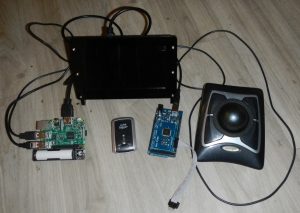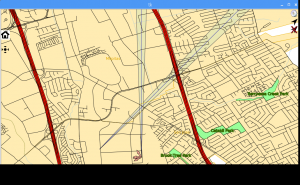T-Hunt GPS – Geneses
After tagging along on the past two SanFransisco bay t-hunts I see a need/use for a GPS unit that is designed around t-hunting. Their for I have created the rudimentary start of one using an old GPS and raspberry pi 3. At present it can, generate maps with manually entered vectors, “error cones” and overlay current AHHA Doppler data.
The “error cones” are to show a fan out of a bearing’s uncertainty i.e. you have a bearing of 282 good to +- 3 degrees it will draw a 6 degree wide cone from the bearing start location.
The AHHA-Doppler functionality needs tested. Up to now I have used dummy data externally generated by an Arduino. At present it overlays a filtered set the last 4 seconds out put, as a cluster of arrows. Presently the Doppler orientation is taken from the GPS heading so it is not accurate at low speeds (<5 mph).
Maps are generated locally using .shp files from various government sources and almost any GIS data can be used. This means it will work out of cell range and is independent of Google.
Technical Details:
Hardware: Raspberry Pi3
Map generation via mapserver ( http://www.mapserver.org/ )
postgreSQL for data logging & GIS shape storage.
The software is written in Python
To Do’s (Just a few of them):
– Test with real AHHA Doppler data. Doppler unit needed with USB to serial converter.-
– Add persistence to the AHHA data (time/space average), I am not sure of the best way to filter the data.
– Optimism the user interface.
I plan on posting source code and set-up scripts and what not GitHub soon.


Hi Jason,
I am a PhD student from ETH in Zurich.
Some time ago I inherited one of your old projects (Trigger Unit from OSU).
Nevertheless, the unit needs some extension and everything is crystal clear in the code, except how you flashed the ‘hello_wold’ project onto the FPGA?
Vivado holds the spi_bootloader ELF file and integrates it into it’s bitstream generation, so far so good. But how is the code from ‘hello_world’ getting into persistent memory?
Thank you in advance for your answer and time.
Kind regards,
Christian